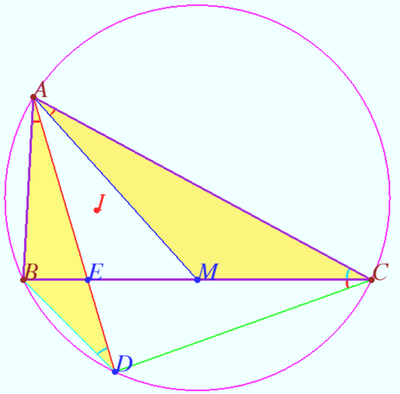Difference between revisions of "Symmedians, Lemoine point"
(Created page with "The reflecting of the median over the corresponding angle bisector is the symmedian. The angle formed by the symmedian and the angle bisector has the same measure as the angle...") |
(→Proportions) |
||
| Line 4: | Line 4: | ||
==Proportions== | ==Proportions== | ||
| + | [[File:Symedian segments.png|400px|right]] | ||
Let <math>\triangle ABC</math> be given. | Let <math>\triangle ABC</math> be given. | ||
| Line 13: | Line 14: | ||
1. Let <math>AE</math> be the symmedian. So <math>\angle BAD = \angle CAM.</math> | 1. Let <math>AE</math> be the symmedian. So <math>\angle BAD = \angle CAM.</math> | ||
| − | <cmath>\angle BDA = \angle ACB = \angle ACM \implies \triangle ABD \sim \triangle AMC \implies \frac {AM}{MC}= \frac {AB}{BD}.</cmath> | + | <cmath>\angle BDA = \angle ACB = \angle ACM \implies \triangle ABD \sim \triangle AMC \implies</cmath> |
| + | <cmath>\frac {AM}{MC}= \frac {AB}{BD}.</cmath> | ||
Similarly <math>\triangle ABD \sim \triangle ADC \implies \frac {AM}{MB}= \frac {AC}{CD}.</math> | Similarly <math>\triangle ABD \sim \triangle ADC \implies \frac {AM}{MB}= \frac {AC}{CD}.</math> | ||
<cmath>BM = MC \implies \frac {BD}{CD} = \frac{AB}{AC}.</cmath> | <cmath>BM = MC \implies \frac {BD}{CD} = \frac{AB}{AC}.</cmath> | ||
| Line 19: | Line 21: | ||
By applying the Law of Sines we get | By applying the Law of Sines we get | ||
<cmath>\frac{AB}{\sin \angle AEB} = \frac{BE}{\sin \angle BAD}, \frac{CD}{\sin \angle CED} = \frac{CE}{\sin \angle CDE},</cmath> | <cmath>\frac{AB}{\sin \angle AEB} = \frac{BE}{\sin \angle BAD}, \frac{CD}{\sin \angle CED} = \frac{CE}{\sin \angle CDE},</cmath> | ||
| − | <cmath>\frac{AC}{\sin \angle ADC} = \frac{BD}{\sin \angle BAD} \implies | + | <cmath>\frac{AC}{\sin \angle ADC} = \frac{BD}{\sin \angle BAD} \implies \frac {BE}{CE} = \frac{AB}{CD} \cdot \frac {BD}{AC} = \frac{AB^2}{AC^2}.</cmath> |
| − | |||
Similarly, <math>\frac {AE}{ED} = \frac{AB^2}{BD^2}.</math> | Similarly, <math>\frac {AE}{ED} = \frac{AB^2}{BD^2}.</math> | ||
2. <math>\frac {BD}{CD} = \frac{AB}{AC}.</math> | 2. <math>\frac {BD}{CD} = \frac{AB}{AC}.</math> | ||
| − | As point <math>D</math> moves along the fixed arc <math>BC</math> from <math>B</math> to <math>C</math>, the function <math>F(D) = \frac {BD}{CD}</math> monotonically increases from zero to infinity. This means that there is exactly one point at which the condition is satisfied. In this case, point <math>D</math> lies on the symmedian. Similarly for point <math>E.</math> | + | As point <math>D</math> moves along the fixed arc <math>BC</math> from <math>B</math> to <math>C</math>, the function <math>F(D) = \frac {BD}{CD}</math> monotonically increases from zero to infinity. This means that there is exactly one point at which the condition is satisfied. In this case, point <math>D</math> lies on the symmedian. |
| + | |||
| + | Similarly for point <math>E.</math> | ||
'''vladimir.shelomovskii@gmail.com, vvsss''' | '''vladimir.shelomovskii@gmail.com, vvsss''' | ||
Revision as of 12:10, 8 July 2024
The reflecting of the median over the corresponding angle bisector is the symmedian. The angle formed by the symmedian and the angle bisector has the same measure as the angle between the median and the angle bisector, but it is on the other side of the angle bisector. The symmedian ![]() is isogonally conjugate to the median
is isogonally conjugate to the median ![]()
There are three symmedians. They are meet at a triangle center called the Lemoine point.
Proportions
Let ![]() be given.
be given.
Let ![]() be the median,
be the median, ![]()
Prove that iff ![]() is the symmedian than
is the symmedian than ![]()
Proof
1. Let ![]() be the symmedian. So
be the symmedian. So ![]()
![]()
![]() Similarly
Similarly ![]()
![]()
By applying the Law of Sines we get
![]()
![]() Similarly,
Similarly, ![]()
2. ![]() As point
As point ![]() moves along the fixed arc
moves along the fixed arc ![]() from
from ![]() to
to ![]() , the function
, the function ![]() monotonically increases from zero to infinity. This means that there is exactly one point at which the condition is satisfied. In this case, point
monotonically increases from zero to infinity. This means that there is exactly one point at which the condition is satisfied. In this case, point ![]() lies on the symmedian.
lies on the symmedian.
Similarly for point ![]()
vladimir.shelomovskii@gmail.com, vvsss










